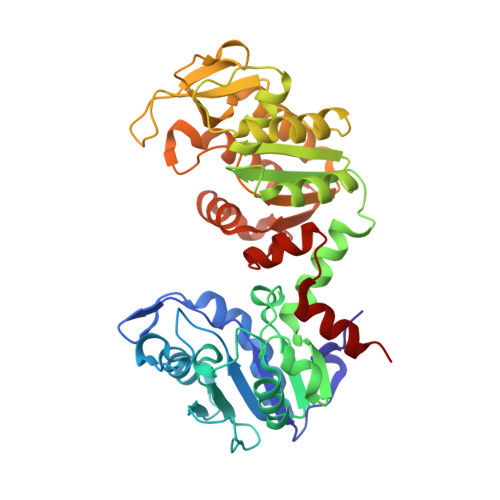Comparison of proteolytic susceptibility in phosphoglycerate kinases from yeast and E. coli: modulation of conformational ensembles without altering structure or stability.
Young, T.A., Skordalakes, E., Marqusee, S.(2007) J Mol Biol 368: 1438-1447
- PubMed: 17397866
- DOI: https://doi.org/10.1016/j.jmb.2007.02.077
- Primary Citation of Related Structures:
1ZMR - PubMed Abstract:
Escherichia coli phosphoglycerate kinase (PGK) is resistant to proteolytic cleavage while the yeast homolog from Saccharomyces cerevisiae is not. We have explored the biophysical basis of this surprising difference. The sequences of these homologs are 39% identical and 56% similar. Determination of the crystal structure for the E. coli protein and comparison to the previously solved yeast structure reveals that the two proteins have extremely similar tertiary structures, and their global stabilities determined by equilibrium denaturation are also very similar. The extrapolated unfolding rate of E. coli PGK is, however, 10(5) slower than that of the yeast homolog. This surprisingly large difference in unfolding rates appears to arise from a divergence in the extent of cooperativity between the two structural domains (the N and C-domains) that make up these kinases. This is supported by: (1) the C-domain of E. coli PGK cannot be expressed or fold independently of the N-domain, while both domains of the yeast protein fold in isolation into stable structures and (2) the energetics and kinetics of the proteolytically sensitive state of E. coli PGK match those for global unfolding. This suggests that proteolysis occurs from the globally unfolded state of E. coli PGK, while the characteristics defining the yeast homolog suggest that proteolysis occurs upon unfolding of only the C-domain, with the N-domain remaining folded and consequently resistant to cleavage.
Organizational Affiliation:
Department of Molecular and Cell Biology and QB3 Institute, University of California, Berkeley, Berkeley, CA 94720-3206, USA.















